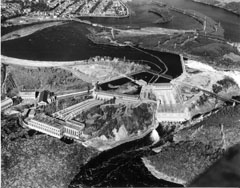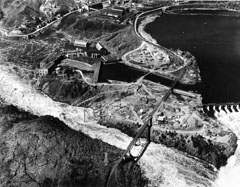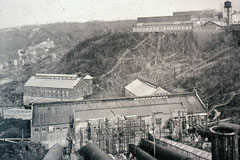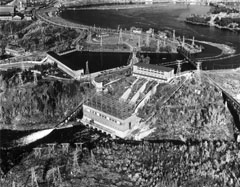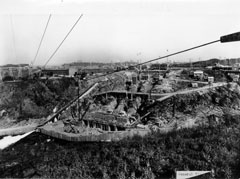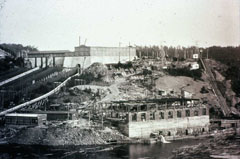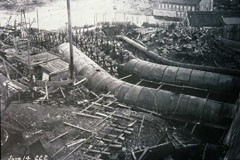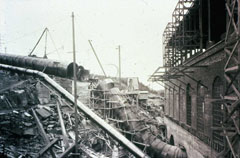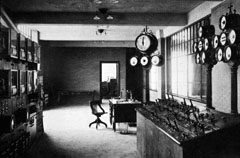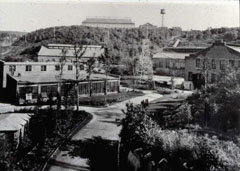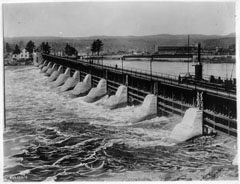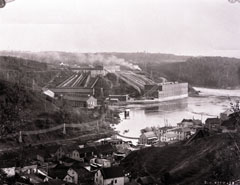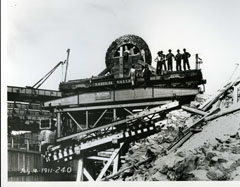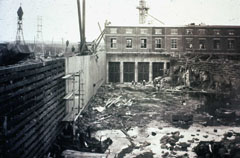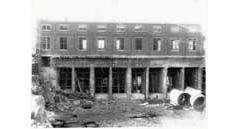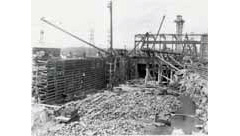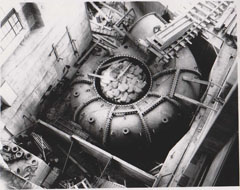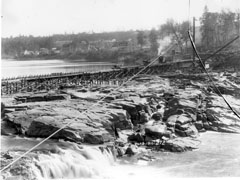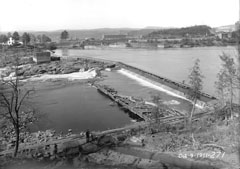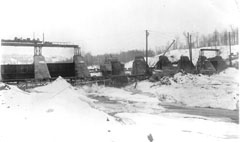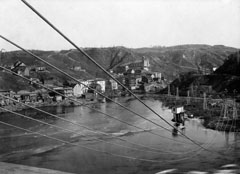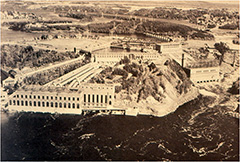Home > History > Shawinigan Water and Power > The Hydroelectric Complex of Shawinigan and the Production and Transmission Network of SW&P
The Hydroelectric Complex of Shawinigan and the Production and Transmission Network of SW&P
The First Components of the Hydroelectric Complex
Headrace
Work began in the spring of 1899 and was carried out by Warren Burnham, under the supervision of the engineering firm of T. Pringle & Son in Montréal. A coffer dam was erected to block the Saint-Maurice River in order to be able to build the headrace. A canal 30 metres wide and 6 metres deep was carved out of the rock over a distance of 300 metres. The sidewall was built with hand-cut stones piled one on top of the other. The south wall was made of wood to facilitate future expansion work.
The headrace was widened first in 1910 during the construction of the Shawinigan-2 generating station. In 1922, the addition of a new turbine at Shawinigan-2 and two more in 1928 and 1929 required an extension to the headrace. In 1946, during the development of the Shawinigan-3 generating station, the headrace was once again expanded.
Penstocks
Two metal penstocks built in 1901 connected the headrace to the Shawinigan Water and Power generating station. A third penstock fed the generating station of Northern Aluminium. New penstocks were built as new turbines were added to the Shawinigan Water and Power generating station. The penstocks, averaging 140 metres in length, were 2.6 metres in diameter and rested on metal structures above ground.
From 1910 to 1914, five penstocks were installed above ground to feed the five turbines of Shawinigan Water and Power's No. 2 generating station. Between 1921 and 1928, three penstocks 180 metres in length and 6 metres in diameter were built underground for the Nos. 6, 7 and 8 vertical axis generators. In 1946, construction began on three penstocks 7 metres in diameter, covering a distance of 92 metres. These penstocks built above ground provided water to the three turbines of the Shawinigan-3 generating station. At the time, concrete cladding on the penstocks was considered an innovation.
Water Intakes
Construction of the first water intake made of reinforced concrete began in the spring of 1900. The wicket had six openings for penstocks. At the very onset of work, plans to add new penstocks to feed Shawinigan Water and Power's No. 1 generating station were already in the making. Management foresight proved invaluable, because four penstocks would be added to the initial two between 1904 and 1909. From 1901 to 1903, a brick building was added above the wicket to protect the mechanisms controlling the gates. This water intake, like the first generating station itself, was shut down in the early 1950s.
In 1910, Shawinigan Water and Power began work on a second water intake adjacent to the first. Five openings were made for the installation of penstocks. Between 1920 and 1928, the intake was expanded twice. Inside the water intake, distribution wells channelled the water from the headrace to the penstocks. The first section of the water intake featured a series of 10 distribution wells feeding five penstocks. The second section contained 15 distribution wells connected to three penstocks, each connected to five wells. Water intake No 3 was built in 1946 in a single unit. It contained nine distribution wells feeding three penstocks.
Inside the water intakes, metal grills installed at the entrance to the distribution wells prevent logs or other debris from entering the penstocks and causing damage to the turbines. The water intakes are equipped with metal gates located near the entrances to the penstocks. The gates prevent water from circulating during turbine maintenance procedures. Each water intake is equipped with a gantry to install beams to block the access and prevent water from entering the distribution wells. At the present time, in 2010, water intakes No 2 and No 3 continue to operate.
Shawinigan-1 Generating Station
On February 5, 1900 engineer Wallace C. Johnson tabled plans for Shawinigan Water and Power's No 1 generating station with the Board of Directors. Mr. Johnson was from Holyoke, Massachusetts and had worked on the development of the Niagara Falls hydroelectric complex begun in 1895. With this experience under his belt, he supervised the construction of the No 1 generating station built by the firm of Warren Scharf of New York. Work began in the spring of 1900 and the foundations of the station were completed by the month of September 1900.
In 1901, work on the station was complete and the first two turbine-generator units began operating the following year. A third turbine was installed in 1904. That same year, Shawinigan Water and Power purchased a new turbine at a cost of $40 000 from the firm of I.P. Morris in Philadelphia. This fourth turbine was commissioned one year later. In 1906 and in 1909, two new turbines were installed at the generating station.
The three first generators produced 3.75 kW at an electromotive force of 2 200 volts. Shawinigan Water and Power purchased a fourth, 6.6kW generator at a cost of $47 500 from Canadian Westinghouse. During the period between June 14 and December 31, 1904, the cost of installing the No 4 turbine-generator combination commissioned the following year was $120 000. In 1907 and 1909, a fifth 6.6 kW generator began operation and a sixth 8 kW generator followed the next year.
In 1903, Shawinigan Water and Power purchased from Westinghouse two transformers capable of stepping up voltage from 2 2000 to 50 000 volts at a cost of $36 298. In 1909 the transformer building at the generating station contained 20 transformers.
The generating station was expanded on two different occasions, in 1904 and 1909, in order to add new turbine-generator units. In 1949, the production of electricity was discontinued with the commissioning of the Shawinigan-3 generating station. In the early 1950s, the Shawinigan-1 generating station was demolished.
Shawinigan-2 Generating Station
In response to increased demand for electricity, Shawinigan Water and Power built a second generating station in 1910. Supervision of the site was entrusted to a young engineer named Julian C. Smith. As of 1933 he would become Chairman of Shawinigan Water and Power and remain in this position until 1939. In 1911, two horizontal axis 11 kW generators began operation. At the time, they were considered among the most powerful generators in America. In 1913, a third generator was commissioned, followed by two others one year later. The addition of units No 4 and No 5 resulted in an expansion of the generating station and the installation of a first vertical axis unit in 1922. Six years later, more construction work was undertaken to install two new vertical axis units. These units were commissioned in 1928 and 1929.
The Shawinigan-2 generating station and its eight generators continue to operate even today, producing 200 megawatts. It is one of the few plants in North America to operate both horizontal and vertical axis generators. This generating station is considered by the Order of Engineers of Canada as one of the great engineering achievements in Canada of the past 123 years.
Shawinigan-3 Generating Station
In 1946, Shawinigan Water and Power built a third generating station at Shawinigan Falls. Contrary to the first two stations, this one was never expanded. It continues to operate today, with three vertical axis generators generating 194 megawatts of power.
NAC Generating Station
Construction of this station began in 1899. Two years later, two direct current generator were commissioned and a third in 1903. Expansion work was undertaken in 1905 and 1906 to install three more generators. This generating station provided power directly to aluminum smelter potrooms. In 1945, production ceased with the shutdown of the potrooms.
Alcan-16 Generating Station
This station built in 1907 operated five direct current generators. Like the NAC generating station, only one penstock fed the turbines. Electricity produced was directed to aluminum smelter potrooms. Production was stopped in 1945.
Funiculars
Building the hydroelectric complex required the construction of funiculars, owing to site geography. The funiculars were used to transport heavy equipment from the top section of the site to the bottom of the slope where the generating stations were being built. During the construction of Shawinigan Water and Power's No 1 station and the NAC generating station, a funicular was used to install the turbines, generators and transformers. The funicular was also used during maintenance work and for some equipment repairs.
At the present time, two funiculars continue to operate: one for the No 2 station and one for the No 3 station. They were installed in 1910 and 1946, respectively, during the construction of the generating stations. It is quite rare to see this type of equipment at a hydroelectric complex.
Spillways
The commissioning of the Shawinigan-2 generating station in 1911 required the construction of two spillways. Their presence allowed the creation of a reservoir on the Saint-Maurice River to ensure a regular supply of water. Work on the two spillways began in 1910. They were built on the Saint-Maurice River from île Melville to create a water reserve. During the 1990s, Hydro-Québec undertook major construction work on the Almaville spillway. Then, in 2006, Hydro-Québec began the replacement of the Melville spillway. Work will be completed in 2011.
Other Generating Stations on the Saint-Maurice River
1916: Commissioning of the Grand-Mère generating station by Laurentide Paper
1924: Shawinigan Water and Power commissions the La Gabelle generating station located 15 kilometres north of the city of Trois-Rivières
1930: Start of the largest construction site of a generating station in Quebec, the Rapide Blanc generating station. This station, located some 200 kilometres north of Trois-Rivières, was commissioned by Shawinigan Water and Power in 1934.
1940: Commissioning of a generating station in La Tuque located 125 kilometres away by Shawinigan Water and Power
1948: Shawinigan Water and Power begins construction of the La Tranche generating station located 43 kilometres from the city of La Tuque. The first turbine-generator units begin production in 1950.
1958: Commissioning of the Beaumont generating station 20 kilometres from the city of La Tuque
2004: Commissioning of the Du Rocher-de-Grand-Mère generating station by Hydro-Québec
Power Transmission Lines
1903: Commissioning of a 50 000-volt power line from the Shawinigan-1 generating station to Montréal. At the time, this 130-kilometre line was the longest and most powerful in Canada.
1904: Shawinigan Water and Power builds a second power line identical to the first to supply electricity to Montréal
1906: Shawinigan Water and Power builds an underwater cable to supply electricity to the south shore of the St. Lawrence River.
1911: A 100 000-volt power line is built between Shawinigan and Montréal.
1916: Beginning of work on a 60 000-volt power line to supply the city of Québec.
1918: Construction of a 1927-metre-long power line 114 metres above the St. Lawrence River. Supported by pylons, this line was the first of its kind in Canada. It supplied electricity to the region of Victoriaville.
1919: A second 60 000-volt power line was built to supply the city of Québec
1925: Shawinigan Water and Power begins the construction of power lines to supply electricity to the countryside.
1941: Construction of a 300 000-volt line between Trois-Rivières and Québec.





